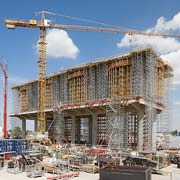
|
contents | technologies | |||||||||
| Cost-effective shoring for high loads in power plant construction  The new block of the largest European lignite-fired power station in the Polish town of Belchatow, has been designed to generate 830 megawatts. The ultra-modern plant complete with flue gas desulphurisation and turbo-generator presents both a technical as well as structural engineering challenge for all those involved in the project. Because the construction of the power plant includes large-volume building dimensions with massive reinforced concrete components - usually carried out during normal plant operations - whilst complying with only small dimensional tolerances in the execution. The new block of the largest European lignite-fired power station in the Polish town of Belchatow, has been designed to generate 830 megawatts. The ultra-modern plant complete with flue gas desulphurisation and turbo-generator presents both a technical as well as structural engineering challenge for all those involved in the project. Because the construction of the power plant includes large-volume building dimensions with massive reinforced concrete components - usually carried out during normal plant operations - whilst complying with only small dimensional tolerances in the execution.Naturally, it´s a good thing if the contractor can rely on one competent partner for all formwork and scaffolding requirements. In this particular case, PERI´s Polish engineers could, on the one hand, take into account all static-related aspects with a well thought-out formwork and shoring concept while, on the other, large quantities of system equipment can be made available within the shortest possible time which is matched to the construction progress at any given point. All this ensures an extremely short construction period along with maximum material utilization. For the sorption facility, a reinforced concrete support structure with two levels at heights of 12 and 25 metres is installed. The slab thicknesses are 25 and 80 centimetres with enormous downstand beam heights of 2.20 to 3.20 metres. In the top slab, four huge 2.20 metre high reinforced concrete rings - each with a six metre internal radius - are integrated which serve to accommodate the 55 metre high steel silos used for storing the sorbent. For this, PERI is supplying a falsework combination consisting of PERI ST 100 stacking towers as well as towers comprised of MULTIPROP aluminium slab props connected with MULTIPROP frames. The modular and flexible PERI MULTIPROP system not only has a high load-bearing capacity but also allows towers to be interlocked in those areas of high load concentrations. Thus, the tower cross-sections - 90 x 90 centimetres internally and 120 x 150 centimetres externally - form extremely high load-carrying units. Supported by ST 100 stacking towers, the loads from the 25 metre high partially cantilevered rings can be safely transferred to the ground. PERI engineers have positioned MULTIPROP and ST 100 for the upper level on a girder grid. This is formed from rentable SRZ and SRU steel walers taken from the VARIO wall formwork programme along with HDT main beams from the HD 200 heavy load system. Optimal load distribution can therefore be achieved on the beams of the 25 centimetre thick intermediate slab which, in turn, means that temporary supports are not required which are material, time as well as cost-intensive. The turbo-generator is supported on a solid, three metre thick reinforced concrete foundation at a height of 18 metres. During construction of the foundations, PERI relied on a type-tested system solution for the heavyweight shoring, namely HD 200 heavy-duty props. This is because forces are created which otherwise frequently arise only in tunnel and bridge construction. Combined with HDT system main beams, this solution offers crucial advantages for the user: simple assembly of the prop segments, controlled lowering with the lowering device - even under 20 tons of load per prop - and the low weight of the HD system components themselves. Due to the detailed PERI planning, the load-bearing capacities of the HD props could be additionally increased thus maximising the span widths. The coupling of three HD 200 sections, arranged one above the other, provides here a reduction in the buckling lengths; in addition, through the combination of HD 200 prop segments made of steel and aluminium, further load optimization is achieved. This creates more working space and shortens assembly times. write your comments about the article :: © 2008 Construction News :: home page |